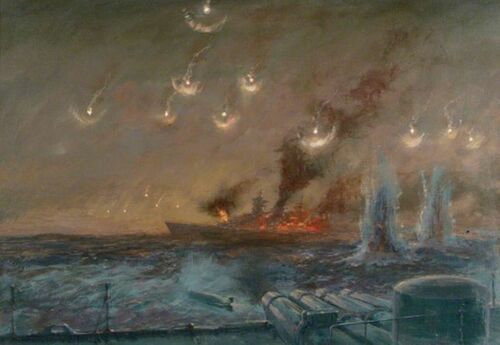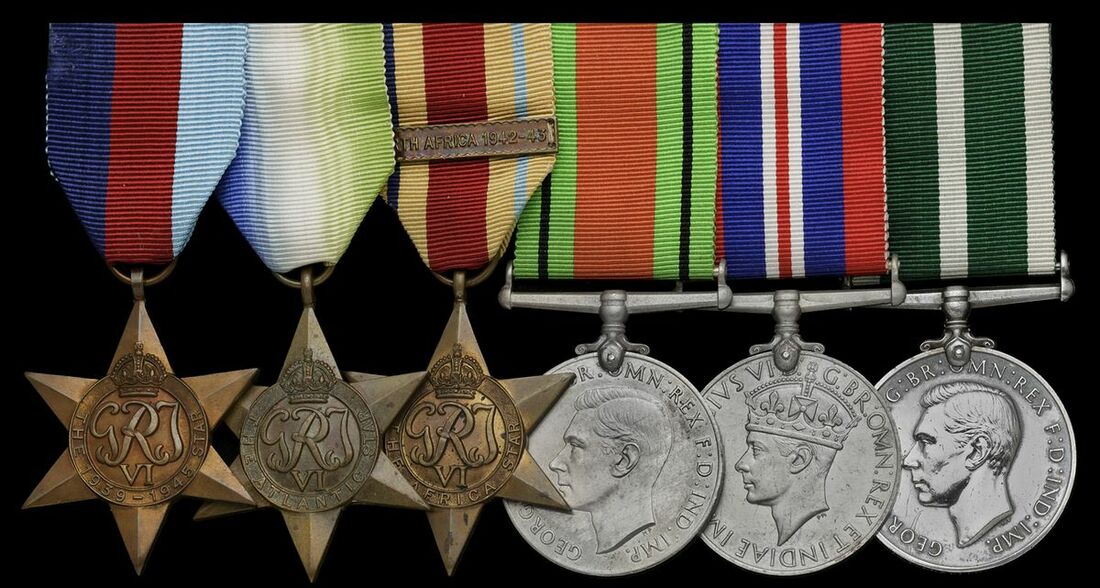Auction: 23001 - Orders, Decorations and Medals
Lot: 193
Six: Leading Seaman I. T. Chatten, Royal Naval Reserve, who saw the destruction of the German Battleship Scharnhorst at the Battle of the North Cape on 26 December 1943 aboard the destroyer Matchless
1939-45 Star; Atlantic Star; Africa Star, clasp, North Africa 1942-43; Defence and War Medals 1939-45; Royal Naval Reserve L.S. & G.C., G.VI.R., (10226. B. I. T. Chatten. L. Smn. R.N.R.), mounted as worn, good very fine (6)
Issac Thomas Chatten was born at North Shields, Tyneside on 23 August 1911, the son of John and Louisa Chatten. Enlisting with the Royal Naval Reserve on 15 June 1932 with the rank of Leading Seaman, he was called up for service on 27 September 1939 and initially served ashore at Victory I and Vernon. Soon, however, he was posted afloat, to the M-class destroyer Marchless.
This vessel was at sea in late-December as part of the British force which closed the net on the German battleship Scharnhorst and her escorts. Early in the morning on 26th December 1943, the German squadron was searching for an Allied convoy in poor weather. Unable to spot any enemy ships, Konteradmiral Erich Bey decided to send the destroyers southward to widen the search perimeter at the risk of leaving Scharnhorst unescorted.
Shortly after 0900 hours, Norfolk and Sheffield detected Scharnhorst off Nordkapp (the North Cape) on the island of Magerøya in northern Norway; they opened fire at the distance of 12,000 metres, hitting Scharnhorst twice, one of which hits put her radars out of commission. Bey ordered Scharnhorst to turn south, successfully moving away from the British ships; once the British cruisers were out of sight, Scharnhorst turned north-east to approach the cruisers at a more favourable angle. Just after 1200 hours, Scharnhorst opened fire, hitting Norfolk, damaging one turret and destroying her radar. Scharnhorst then once again turned south and this time Burnett's cruisers pursued, providing the Duke of York's group regularly-updated positions. At 1615 hours, Duke of York located Scharnhorst on radar, but Scharnhorst was unaware of her arrival on the scene.
At 1648 hours, Belfast fired star shells, illuminating Scharnhorst for Duke of York. The British battleship fired at the range of 10,900 metres, scoring a hit with her first salvo, disabling Scharnhorst's forwardmost turret. Another hit some time later destroyed the aircraft hangar. As Scharnhorst attempted to escape to the south, Belfast and Norfolk continued to give chase. At 1820 hours, Duke of York scored another hit on Scharnhorst, the shell detonating in the No. 1 boiler room, causing Scharnhorst's speed to decrease to 10 knots. At 1825 hours, Bey radioed the message "We will fight on until the last shell is fired." At 1850 hours British destroyers caught up with Scharnhorst, scoring gun and torpedo hits. Duke of York and Jamaica attacked at about 1900 hours at the range of 9,500 metres, and at 1915 hours Belfast joined in as well. Already heavily damaged, Scharnhorst suffered another round of multiple torpedo hits and finally sank at 1945 hours. Of her complement of nearly 2,000 only 36 were rescued; Admiral Bey was not among them.
Chatten went on to see service with H.M.S. Wagtail, finally being demobilised on 2 November 1945. Upon demobilisation he returned to North Shields where he died in 1997 and was buried at Preston Cemetery with his wife, Lucy; sold together with copied service papers, burial details and an action report for the commander of H.M.S. Matchless, relating to the sinking of the Scharnhorst.
Subject to 20% VAT on Buyer’s Premium. For more information please view Terms and Conditions for Buyers.
Sold for
£200
Starting price
£110







